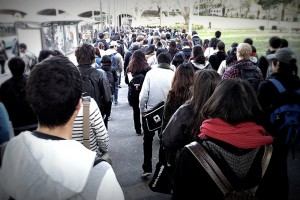Finance ministers the world over are renowned fans of the so-called ‘one-stop-shop’ where multiple government services get bundled together into a single retail outlet to save citizens running around and taxpayers big dollars on rent and wages.
But if you head out to pay a bill or renew your licence at lunchtime, more services can mean longer queues and a break spent standing in line or waiting for your number to be called.
That could be about to change in New South Wales after the state government made a pledge to its customers that it will publicly reveal waiting times in queues at its Service NSW offices — not in retrospect, but in real time.
Launched in 2013, Service NSW is now the main access pointy for more than 800 government transactions — like licences, vehicle registrations, Seniors Card applications, owner builder permits and housing payments — that were previously distributed across multiple offices and agencies, many of which had less than convenient opening hours.
Now NSW Minister for Finance, Services and Property Dominic Perrottet (who’s known for his passionate pursuit of better capacity utilisation ) is betting that millions of customers will organically opt for shorter waiting time times if they can see up to the minute on how they will have to wait.
The theory is pretty simple: people will naturally opt for the shortest transaction time if they can see it, thereby taking pressure off during peak times.
According to Mr Perrottet, the new heads-up to citizens on waiting times will be delivered through (you guessed it) another nimble government issued smartphone app. But it will also be made available on the Service NSW websites.
“Customers can now beat the queues by seeing how long they’ll have to wait before deciding whether to visit a service centre, Mr Perrottet said.
“That helps customers make informed decisions about which centres to visit and how to avoid peak periods such as lunch times and the lead up to holiday periods.”
But the same information will also give the minister and Service NSW senior management a far more detailed view of individual shopfronts perform and when there are quiet periods.
Fast food retailers, airlines and transport authorities and call centres have for years harnessed queuing data as a way to manage capacity and load, but the application of the technique in government is relatively new.
If the innovation is successful, which is more than likely, there is a fair chance it could be applied to federal government services like Centrelink and Medicare which have been gently pushing customers towards online channels.
However a challenging side effect of the online push in the social security system has been that customers that wind up at an office are often more challenging for staff to deal with because their circumstances can’t be immediately addressed via an online transaction.






The services should not be bundled up the way they are. No matter what time of day you go to services nsw the queue is hours long. It’s unfair to the public because we too have to work. It’s completely inefficient because it means that productivity for the working public is being compromised. We too have jobs that run the country not just government departments. If it weren’t for the private sector there’d be a lot of unemployment. Stop trying to say that this service is efficient when it isn’t. It’s all a money saving ploy by the government to make the rest of us suffer.
Queues are still cheaper
2013, experiment of bundling of 800 service transactions into Service NSW centres. was not driven with the overhaul of the complexity or requirements of each of these service transactions. only the back-end was massaged.
So, for the most part the complexity of many of those transactions have remained unchanged.
We have the convenience of only having to go to one place to get these services.
The numbers of Service centres and on duty staff to service those centres has been rather static. The population requiring these transaction grown. and the point of processing (queuing) not necessarily increased.
So it’s meant that the length and location of the queue was changed.
So, 800 transactions, some of these had minor Structural change in the service transactions. Many would require in to Acts or legal steps that our Judicial system require to be executed. To be streamlined and made totally digital. It’s a costly activity.
Still Government has decided that queues are cheaper!
Given that both Online queues and physical are just as bad!